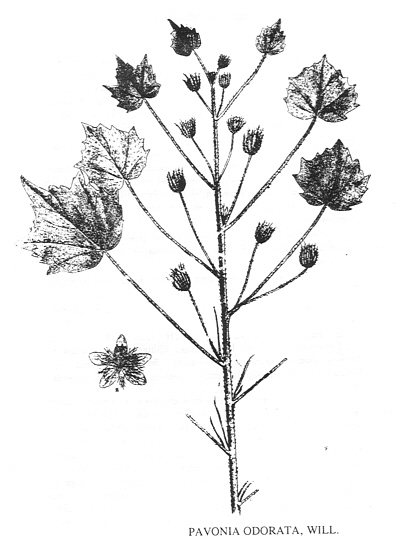

Zitierweise / cite as:
Carakasaṃhitā: Ausgewählte Texte aus der Carakasaṃhitā / übersetzt und erläutert von Alois Payer <1944 - >. -- Anhang A: Pflanzenbeschreibungen. -- Pavonia odorata Willd. -- Fassung vom 2007-06-27. -- URL: http://www.payer.de/ayurveda/pflanzen/pavonia_odorata.htm
Erstmals publiziert: 2007-06-27
Überarbeitungen:
Anlass: Lehrveranstaltung SS 2007
©opyright: Dieser Text steht der Allgemeinheit zur Verfügung. Eine Verwertung in Publikationen, die über übliche Zitate hinausgeht, bedarf der ausdrücklichen Genehmigung des Verfassers
Dieser Text ist Teil der Abteilung Sanskrit von Tüpfli's Global Village Library
WARNUNG: dies ist der Versuch einer
Übersetzung und Interpretation eines altindischen Textes. Es ist keine
medizinische Anleitung. Vor dem Gebrauch aller hier genannten Heilmittel wird
darum ausdrücklich gewarnt. Nur ein erfahrener, gut ausgebildeter ayurvedischer
Arzt kann Verschreibungen und Behandlungen machen!
Falls Sie die diakritischen Zeichen nicht dargestellt bekommen, installieren Sie eine Schrift mit Diakritika wie z.B. Tahoma.
Verwendete und zitierte Werke siehe: http://www.payer.de/ayurveda/caraka0001.htm

Abb.: Pavonia odorata Willd.
[Bildquelle: Kirtikar-Basu, ©1918]
Drury:
"Pavonia odorata (Willd.) N. O. Malvaceae.
- Peramootie, Tam.
- Mootoo-polagum, Tel.
Description—Shrub, 2-3 feet; calyx 5-cleft; involucel 12-leaved, ciliated, longer than the calyx; stems viscidly hairy; leaves cordate, roundish-ovate, upper one 3-lobed, toothed, more or less hairy and viscid, lower ones sometimes entire; pedicels axillary, 1-flowered; carpels 5, 2-valved,-1-seeded, not prickly; flowers rose-coloured. Fl. Nearly all the year.—W. & A. Prod. i. 47.—Roxb. Fl. Ind. iii. 214.-------Dindigul hills. Vendalore. Coromandel.
Medical Uses.—The root is used in infusion as a diet-drink among the Hindoos in fevers. It is thick as a quill and light-coloured.—Wight."
[Quelle: Drury, Heber <1819 - 1872>: The useful plants of India : with notices of their chief value in commerce, medicine, and the arts. -- 2d ed. with additions and corrections. London : Allen, 1873. -- xvi, 512 p. ; 22 cm. -- s.v.]
Dutt:
"PAVONIA ODORATA. Sans, Bālā, Hrivera. Vern. Sugandha bālā, Hind.
The fragrant roots of this plant are considered aromatic, cooling and stomachic and are much used in combination with other medicines of the sort in fever, inflammation, haemorrhage from internal organs etc. Bālā enters into the composition of a well-known fever drink called shadanga pāniya, (see Andropogon muricatum)."
[Quelle: Dutt, Uday Chand: The materia medica of the Hindus / Uday Chand Dutt. With a glossary of Indian plants by George King. -- 2. ed. with additions and alterations / by Binod Lall Sen & Ashutosh Sen. -- Calcutta, 1900. - XVIII, 356 S. -- S. 123.]